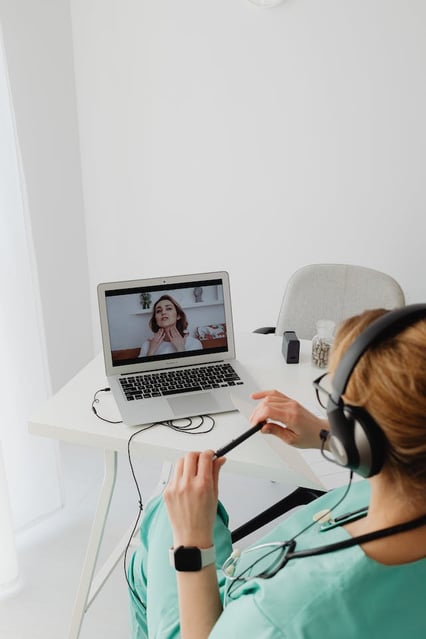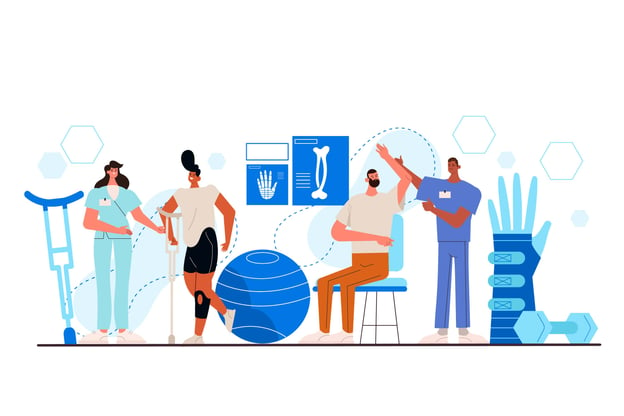September 25, 2023
CPT Modifiers Explained - With Examples for Physical Therapists
Physical therapists have a unique challenge when it comes to billing. With several codes and modifiers to keep track of, things can get confusing quickly. That's why it's essential to get acquainted with the CPT modifier list and understand how they work so you can ensure proper reimbursement for your services.
We've put together a few examples of how CPT modifiers work in real-life scenarios so you can better understand when and how to use them.
CPT Modifiers with Examples
What is a CPT modifier? Let's take a look at some different scenarios to better understand CPT modifiers:
 Scenario #1:
Scenario #1:
Let's start with an example of a patient seen for lymphedema therapy. To correctly bill the insurance company, you must add modifier 97 (unusual procedure) with the CPT code 97140 manual lymphatic drainage. Adding this modifier ensures that the insurer is aware of your use of a specialized technique for the service provided.
Scenario #2:
Another example would be when dealing with a patient with multiple co-existing conditions. To bill appropriately, you must add modifiers 59 (distinct procedural service) and 51 (multiple procedures). Modifier 59 informs the insurer that the two treatments performed are for different services, while modifier 51 alerts them that you are performing two or more separate treatments on the same day.
Scenario #3:
Finally, another scenario might be a patient seen for multiple visits during a single day. In this instance, you must add modifier 58 (staged or related procedure) and CPT code 97140. Modifier 58 lets the insurance company know that the treatments are part of a single course of treatment and require more than one visit.
What are CPT Modifiers Used For?
So, as you can see, CPT modifiers provide extra details concerning a procedure or service provided by a physician. They allow medical billing companies to accurately describe and bill for services so they can get the proper reimbursement. With a better understanding of how CPT modifiers work, you can ensure that your patients' treatments are correctly and promptly billed.
Now that we've discussed CPT modifiers in the context of physical therapy, let's consider how we can use them for other specialties. For example, in the case of radiology procedures, you might need to add modifier 77 (repeat procedure) if a patient is undergoing a repeat test or procedure. It lets the insurance company know that this service has been requested and is the same procedure as last.
In addition, modifiers such as 33 (preventive service) might indicate that a patient is being seen for preventive care rather than a specific condition or injury. It helps insurance companies accurately differentiate between the services provided to reimburse providers better.
Most Common Physical Therapy CPT Modifiers?
The most common CPT modifiers are nominated by letters or numbers. For example, the modifier -22 indicates increased services, while -52 means reduced fees. Other modifiers include -59 for distinct procedural service, -95 for telehealth, and -96 -97 for habilitative and rehabilitative services, respectively.
We can change the physical therapy modifiers to indicate that a specific type of health provider performed the service. For instance, the modifier -CO is used for services provided by certified occupational therapy assistants (COTAs), while -CQ is for physical therapy assistants (PTAs). The modifiers -GN, -GO, and -GP stands for speech-language pathologists (SLPs), occupational therapists (OTs), and physical therapists (PTs), respectively. Finally, the modifier -KX indicates the exceeded Medicare cap.
Understanding CPT Medicare modifiers is crucial to accurately reporting the services provided in your practice. Familiarizing yourself with the most common codes and their definitions will help ensure that your billing complies with Medicare regulations. With this knowledge, physical therapists can confidently provide the quality care their patients need.
Comprehensive List of CPT Modifiers for Physical Therapy:
These CPT modifiers are used to provide additional information about the provided service, ensuring appropriate billing and accurate medical records. They clarify specifics such as the type of therapy, complexity, distinct services, and more. Use this list as a quick reference to ensure accurate coding and compliance with billing requirements for physical therapy services.
| Modifier | Description |
| Functional Modifiers: | |
| GN | Services delivered under an outpatient speech-language pathology plan of care |
| GO | Services delivered under an outpatient occupational therapy plan of care |
| GP | Services delivered under an outpatient physical therapy plan of care |
| Level of Complexity: | |
| CO | Outpatient therapy functional reporting, composite functional limitation |
| CM | Outpatient therapy functional reporting, mobility: walking & moving around |
| CN | Outpatient therapy functional reporting, changing & maintaining body position |
| Time-Based Modifiers: | |
| KX | Requirements specified in the medical policy have been met |
| Therapy Modifiers: | |
| 59 | Distinct procedural service |
| 76 | Repeat procedure or service by same provider |
| 77 | Repeat procedure by another provider |
| SA | Nurse practitioner rendering service in collaboration with a physician |
| SB | Nurse midwife |
| SC | Medically necessary service or supply |
| GP | Physical therapy services provided under an outpatient plan of care |
| Rehabilitative Services: | |
| 96 | Habilitative services |
| 97 | Rehabilitative services |
Understanding CPT Modifiers:
The world of medical billing can be complex and confusing at times, especially when it comes to modifiers. Modifiers are two-digit codes added to a CPT code to provide additional information. They play a significant role in healthcare billing, ensuring all services rendered are appropriately billed and reimbursed. But, with so many different types of modifiers out there, it can be overwhelming to keep track of them all.
In this blog post, we will provide a CPT code modifiers list to help you better understand them and explain what each of them is used for.
-22 Modifier:
This modifier for physical therapy indicates that the procedure was more extensive than usual. For instance, if a surgeon had to perform more work than anticipated to complete a procedure, they would use an -22 modifier PT code to indicate that they did an additional job. For example, if a surgeon decided to remove an additional organ during surgery, they would use the -22 modifier.
-52 Modifier:
This modifier indicates a reduced service. We can use it when a service is less than expected for the procedure. For instance, if a patient could not complete an entire physical therapy session, a -52 modifier indicates that they only completed a partial service.
-59 Modifier:
This modifier indicates that a service or procedure is distinct or separate from other services performed. When a health professional performs a procedure at a different body location or session than other procedures, for instance, if a patient received two vaccination shots in various locations during a visit to the doctor, the -59 modifier would indicate that the two services were separate.
-95 Modifier:
This modifier represents synchronous telemedicine services that are part of an extended limited visit. We need to append this modifier when a patient receives remote services during a visit to a physician's office. For example, suppose a patient visited a doctor's office for a routine checkup, and the doctor referred them for remote counseling.
-96 Modifier:
This modifier indicates a service given through telecommunication services. It is used when a healthcare provider furnishes remote assistance to a patient, such as online habilitative services. For instance, if a patient received online habilitative services with a doctor, the -96 modifier would indicate that the service was provided remotely.
CO, CQ, GO, GP:
These modifiers fall under the therapy services category and indicate which therapy or service was provided. CO means an outpatient rehabilitation service; CQ suggests that a clinical psychologist performed the service; GO indicates that the service was related to a diagnosis of optometry or ophthalmology; and GP is used for therapy services to address a patient's condition.
KX modifier:
This modifier is used in preceding codes for therapy services to indicate that the service provided was medically necessary. For example, if a patient received occupational therapy for a chronic condition, the KX modifier would suggest that the service provided was medically necessary.

Understanding CPT Modifiers in Real Life Scenarios:
CPT modifiers are crucial in the healthcare industry, ensuring accurate billing and coding. These modifiers for CPT codes provide additional information about the services rendered or the circumstances surrounding the treatment. We will investigate real-life scenarios involving CPT modifiers, particularly post-ACL reconstruction rehabilitation. Understanding these scenarios will give you an idea of how these modifiers apply to different treatment plans and will help you avoid claim denials.
Scenario #1 - Post-ACL Reconstruction Rehabilitation
A 25-year-old patient underwent anterior cruciate ligament reconstruction surgery following a sports injury. The physical therapist devised a comprehensive treatment plan to regain strength and mobility—the treatment plan involved therapeutic exercises (CPT 97110) and neuromuscular reeducation (CPT 97112). Manual therapy (CPT 97140) was also included to relieve discomfort and facilitate tissue healing.
The Claim:
The physical therapist combined therapeutic exercises and neuromuscular reeducation during the session, and the physical therapy modifier GP applies, as these services are not mutually exclusive. A KX modifier should also support the claim for additional sessions since manual therapy is medically necessary for post-operative care.
Scenario #2 - Chronic Back Pain Management
Modifiers are two-digit codes added to CPT codes, providing additional information about services rendered. They are used to help identify the specifics of the performed service, such as the location of the service or if the service was repetitive or distinct from other services performed. Appropriate use of modifiers is essential as they can affect reimbursement.
Let's look at a scenario to understand the use of CPT modifiers better. Imagine a 60-year-old patient with chronic back pain that hinders their daily activities. The physical therapist (PT) initiates a tailored plan to alleviate pain and improve functionality. The treatment involves manual therapy (CPT 97140) to target trigger points and mobilize the spine and therapeutic exercises (CPT 97110) to strengthen core muscles and promote flexibility.
The Claim:
For this scenario, the appropriate modifier for both CPT codes is GP, indicating that a qualified healthcare professional provides the services. For the manual therapy and therapeutic exercises, an additional modifier is necessary to suggest that these procedures are distinct. The 59 modifier indicates the distinct procedural service.
It's essential to note that the KX modifier is not necessary in this scenario, as the patient has yet to exceed their annual therapy threshold. However, if the patient had reached their therapy threshold, it would be appropriate to add the KX modifier, which indicates that the service is medically necessary.
Scenario #3 - Pediatric Developmental Delay Intervention
To illustrate how CPT modifiers support pediatric developmental delay intervention in real-world scenarios, here's an example:
A 4-year-old child comes to an occupational therapist (OT) due to developmental delays affecting their motor skills and sensory processing. Based on an initial assessment, the OT devises a personalized plan that includes sensory integration therapy (CPT 97533) to address sensory processing and promote adaptive responses. Additionally, the OT incorporates therapeutic activities (CPT 97530) to encourage fine and gross motor skill development.
The Claim:
To ensure accurate billing, the professional must include several modifiers, such as GO, 59, and KX, in their claim.
However, in specific situations, a CPT modifier is necessary to distinguish procedures, guide claims, or provide further clarification. For pediatric developmental delay intervention, there are several modifiers that help differentiate treatments. As a rule of thumb:
- The services are provided by an Occupational Therapist (OT), therefore, the appropriate you should use the GO modifier.
- Therapeutic procedures, such as sensory integration therapy (CPT 97533) and therapeutic activities (CPT 97530), are distinct and separate services requiring 59 modifier to support the claim for both treatments.
- When the patient requires frequent intervention, the provider should add the KX modifier to signify medically necessary treatment.
Scenario #4 - Post-Stroke Rehabilitation
In this scenario, a 65-year-old patient seeks physical therapy to improve their walking abilities and balance. The physical therapist develops a comprehensive treatment plan that includes gait training (CPT 97116) and therapeutic exercises (CPT 97110) to enhance muscle strength and coordination.
The Claim:
 The first modifier we need to consider is GP, which indicates that a physical therapist provided the service. Since the gait training and therapeutic exercises are separate and distinct services, we need to use the 59 modifier. This modifier is used to identify procedures or services that are not usually reported together but are appropriate in particular circumstances. In this case, the therapeutic exercises are distinct from the gait training, and both are necessary for the patient's rehab.
The first modifier we need to consider is GP, which indicates that a physical therapist provided the service. Since the gait training and therapeutic exercises are separate and distinct services, we need to use the 59 modifier. This modifier is used to identify procedures or services that are not usually reported together but are appropriate in particular circumstances. In this case, the therapeutic exercises are distinct from the gait training, and both are necessary for the patient's rehab.
In addition to the GP and 59 modifiers, we must include the KX modifier. This modifier indicates that the service rendered is medically necessary and meets coverage criteria. In this case, the patient's post-stroke condition requires ongoing therapy, so applying the KX modifier shows that the treatment is needed and not just preventive.
The resulting modifiers and procedure codes for the scenario are 97116: GP, 59, KX and 97110: GP, 59, KX. Each code represents a different service, and each modifier conveys critical information about the service provided. By accurately applying these modifiers, healthcare professionals can ensure that patients receive the care they need and are reimbursed for their services.
Common Billing Mistakes and How to Avoid Them
Physical therapists often encounter specific challenges in billing due to the nuanced nature of CPT modifiers. Recognizing and avoiding common billing mistakes is crucial for ensuring claims are processed smoothly and reimbursements are received without delay.
Incorrect Modifier Use
One of the most common errors involves applying modifiers incorrectly. For instance, using modifier -59 (Distinct Procedural Service) when services are not truly distinct can lead to claim denials. To avoid this, ensure that you fully understand the criteria for each modifier. Resources like the AMA's CPT manual and CMS guidelines can provide clarity.
Overlooking New Modifiers
CPT codes and modifiers are updated annually, sometimes adding new modifiers or revising existing ones. Missing these updates can result in using outdated codes, leading to denied claims. Subscribing to newsletters from professional associations and attending coding seminars can help keep your knowledge current.
Failing to Document Justification
Every use of a modifier must be justified in the patient's medical record. If a claim is reviewed and the documentation does not support the modifier used, it may be denied. Ensure that documentation includes a clear rationale for each modifier, tying it back to specific treatment details and patient conditions.
Misunderstanding Payer Policies
Insurance companies may have their own guidelines for using certain modifiers. Misinterpreting these policies can lead to billing errors. It's beneficial to review the billing guidelines of the insurance providers you work with most frequently and to establish a direct line of communication for clarification on modifier use.
Preventive Measures
- Conduct Training: Regularly train your billing staff and therapists on the latest coding practices, including proper modifier use.
- Use Billing Software: Many modern billing systems include features that alert users to potential errors or omissions in modifier application.
- Implement a Review Process: Before submitting claims, have them reviewed by another member of your team for accuracy.

Navigating Insurance Policies and CPT Modifiers
Insurance policies regarding CPT modifiers can vary significantly, making it essential for physical therapists to understand and navigate these differences effectively.
Understanding Payer Specifics: Each insurance company may interpret and require the use of CPT modifiers differently. Reviewing the provider manual or billing guidelines for each insurance payer you work with can provide clarity on their specific requirements.
Dealing with Denials: If a claim is denied due to modifier use, first review the claim and your documentation to ensure correctness. If the denial is unjustified, appeal the decision by providing detailed documentation and citing the specific payer policy that supports your billing.
Effective Communication: Establishing a rapport with insurance representatives can be invaluable. When in doubt about how to use a modifier for a specific service, don't hesitate to reach out to the insurer for clarification before submitting the claim.
🚨 Steps to Appeal a Denied Claim Due to Modifier Errors
1️⃣ Identify the Denial Code – Check the explanation of benefits (EOB) or remittance advice (RA) to see why the claim was rejected.
2️⃣ Review Documentation – Ensure patient notes justify the service and support the modifier used.
3️⃣ Verify Payer Rules – Some insurers have specific rules for modifier combinations—check their billing guidelines.
4️⃣ Submit a Corrected Claim – If the wrong modifier was used, resubmit the claim with the correct modifier and attach supporting documentation.
5️⃣ File a Formal Appeal (If Needed) – If the claim is still denied, submit a written appeal including:
- A corrected claim form
- Supporting clinical documentation
- A letter explaining why the modifier was appropriate
6️⃣ Track the Appeal Status – Follow up regularly with the insurer until the claim is processed.
🔥 Pro Tip:
Using billing software with built-in modifier validation can help prevent denials before they happen!
Frequently Asked Questions?
What is the Difference Between Modifiers -59 and -51?
Modifier -59 is used to indicate that a procedure or service is distinct from others performed on the same day, while modifier -51 is used for multiple procedures performed during the same session. -59 highlights distinct services, whereas -51 focuses on the quantity of procedures.
Can the Same Modifier Be Used for Different Treatment Sessions on the Same Day?
Yes, if the clinical situation justifies it. For example, modifier -59 can be applied to different services provided in separate, distinct sessions on the same day, assuming documentation supports the distinction.
How Do I Know When to Use the -22 Modifier for Increased Procedural Services?
The -22 modifier should be used when the service provided is significantly more complex or time-consuming than typically required. Documentation should clearly describe the additional work and why it was necessary.
Are There Modifiers That PTs Should be Aware of for Telehealth Services?
Yes, with the expansion of telehealth, modifiers such as -95 have become increasingly relevant. This modifier indicates that a service was delivered synchronously via telecommunications technology. Physical therapists should stay informed about these and other emerging modifiers to ensure accurate billing for telehealth services.
How to Practice With CPT Modifiers and Codes for Easy Billing
Learning CPT codes and modifiers is essential. Without them, there is a risk of claim rejections or underpayment issues. An incorrect code can cause a denial claim, while missing modifiers can result in partial payment.
On the other hand, using the proper codes and modifiers will improve the accuracy of claims submissions, resulting in faster and more accurate payments. With PtEverywhere, therapy practitioners can stay up-to-date and confident with their billing processes.
Let's take a closer look at how PtEverywhere can help you master CPT codes and modifiers for your PT practice.
Gain Full Understanding of CPT Codes and Modifiers
Let's explore the benefits of using PtEverywhere to practice CPT codes and modifiers. Not only is PtEverywhere a fully digital practice management software that allows therapists to manage all their clients in one place, but it also provides an easy-to-use platform for therapy practice billing. PtEverywhere therapists can apply modifiers and codes with confidence while streamlining their billing process. The software also offers speech therapy-specific codes, making navigating the entire billing process easy.
Perfect Your Coding and Modifying Skills
Let's discuss how therapists can use PtEverywhere to practice coding and modifying. One of the best ways to succeed with PtEverywhere is to set up the system correctly from the beginning. It includes entering accurate patient information, verifying insurance information before beginning treatment, and understanding the procedure codes used in speech therapy billing. Once billing and patient information is entered correctly, it's easy to select procedure codes and modifiers for the claim and all the associated information is stored in one place.
Streamline Your PT Management Process
Let's look at features of PtEverywhere that make it an easy system for therapists. Providers can easily select the proper codes and apply the correct modifiers through a fully connected and interactive workflow. The system can also read patient data in real time, allowing providers to track progress and adjust treatment approaches. PtEverywhere provides more accurate billing and better patient outcomes through a streamlined and user-friendly system.
Conclusion
Although it may initially seem complicated, mastering the proper application of CPT modifiers is critical for physical therapists looking to streamline and optimize their billing processes. Using the appropriate modifier with CPT codes allows for the adequate classification of claims submissions and impacts the amount of reimbursement received. With software like PtEverywhere, physical therapists can apply modifiers and codes confidently, resulting in accurate claims submissions and more streamlined billing processes.
In conclusion, physical therapists must understand CPT modifiers to ensure proper reimbursement. Using CPT modifiers with codes provides additional detail for services and procedures provided by a therapist, helping optimize claims submissions.
By mastering CPT modifiers, physical therapists can reduce errors and increase reimbursement, putting their practice on the road to success.


